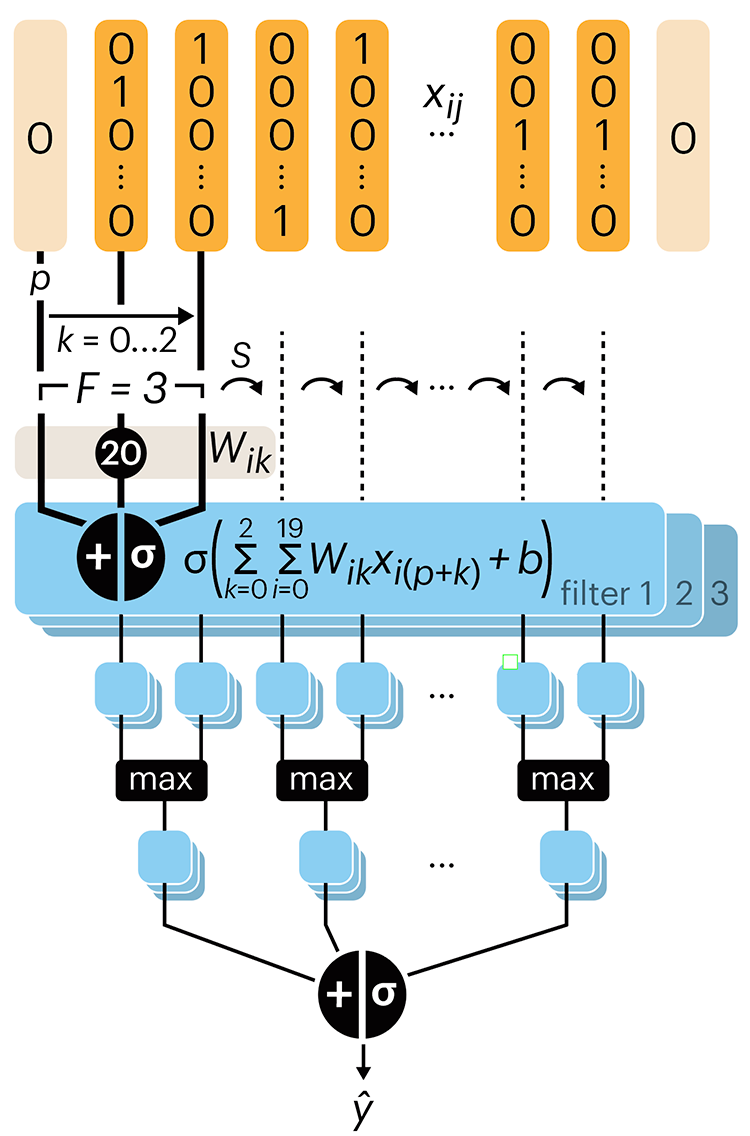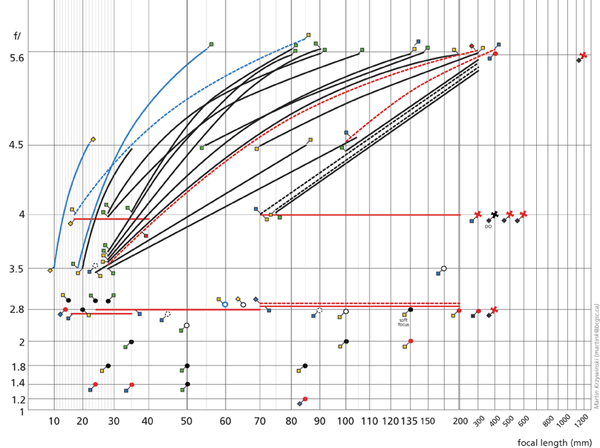Canon EF Lenses
the chart
Each prime lens on the chart is represented by a point given by the lens' focal length (mm) and maximum aperture. Zoom lenses are shown as curves whose end points correspond to the lens' maximum aperature at its lowest and highest focal lengths. The path of the curve does not reflect the relationship between focal length and maximum aperture - the curve is routed to minimize, where possible, the number of intersection with other curves. Prices are based on listings at adorama.com.
lens information
Don't be surprised if the information in the pages below isn't updated frequently. Lens technology is improved incrementally and new lens launches are infrequent.
- Canon offers a lot of information about their lenses. A lot of it is very readable, regardless of level and knowledge of the Canon line up. An EF Lens 101 covers the basics. Canon offers an individual summary for each of its EF lenses, which includes sample images and MTF. A complete EF lens spec sheet is also available (local copy).
- Canon publishes the modulation transfer function profiles (wtf is mtf?) for all EF lenses. This is a good thing. The MTF profiles are computed, however, not based on real performance. To compare two MTF functions try Andrew's Magnificent MTF Comparometer.
- An excellent EF Lens Beginner's FAQ is provided by NK Guy. This section of the FAQ is part of a larger EOS Beginner's FAQ. Even if you are a seasoned pro, I highly recommend this resource.
- Finally, if you want to know everything about EF lenses from the horse's mouth, pick up a copy of Canon EF Lens Works III. It's a Canon publication, thus shamelessly self-contratulatory and at times extremely poorly written and downright cheesy, but it does provide (a) description of every lens, (b) sample images for each lens, some breathtaking, (c) MTF functions, including with 1.4x and 2x extenders, (d) description of Canon technology and (e) pretty comprehensive optical glossary. At $20 is a very good buy.
lens reviews
- fredmiranda.com publishes user reviews of Canon, as well as other, lenses. Good reading if you want to know what a lot of people who use the lenses actually think.
- Reviews by William L Castleman of a large number of L lenses. The reviews are well written, and of a technical nature, making use of images of mannequins to illustrate lens characteristics and resolution plots.
- Bob Atkins reviews not only Canon but also some Tamron lenses.
- A large number of reviews at The Digital Picture. A lot of the reviews of similar lenses use the same text and are heavy on describing features more than performance.
Nasa to send our human genome discs to the Moon
We'd like to say a ‘cosmic hello’: mathematics, culture, palaeontology, art and science, and ... human genomes.



Comparing classifier performance with baselines
All animals are equal, but some animals are more equal than others. —George Orwell
This month, we will illustrate the importance of establishing a baseline performance level.
Baselines are typically generated independently for each dataset using very simple models. Their role is to set the minimum level of acceptable performance and help with comparing relative improvements in performance of other models.

Unfortunately, baselines are often overlooked and, in the presence of a class imbalance5, must be established with care.
Megahed, F.M, Chen, Y-J., Jones-Farmer, A., Rigdon, S.E., Krzywinski, M. & Altman, N. (2024) Points of significance: Comparing classifier performance with baselines. Nat. Methods 20.
Happy 2024 π Day—
sunflowers ho!
Celebrate π Day (March 14th) and dig into the digit garden. Let's grow something.

How Analyzing Cosmic Nothing Might Explain Everything
Huge empty areas of the universe called voids could help solve the greatest mysteries in the cosmos.
My graphic accompanying How Analyzing Cosmic Nothing Might Explain Everything in the January 2024 issue of Scientific American depicts the entire Universe in a two-page spread — full of nothing.
The graphic uses the latest data from SDSS 12 and is an update to my Superclusters and Voids poster.
Michael Lemonick (editor) explains on the graphic:
“Regions of relatively empty space called cosmic voids are everywhere in the universe, and scientists believe studying their size, shape and spread across the cosmos could help them understand dark matter, dark energy and other big mysteries.
To use voids in this way, astronomers must map these regions in detail—a project that is just beginning.
Shown here are voids discovered by the Sloan Digital Sky Survey (SDSS), along with a selection of 16 previously named voids. Scientists expect voids to be evenly distributed throughout space—the lack of voids in some regions on the globe simply reflects SDSS’s sky coverage.”
voids
Sofia Contarini, Alice Pisani, Nico Hamaus, Federico Marulli Lauro Moscardini & Marco Baldi (2023) Cosmological Constraints from the BOSS DR12 Void Size Function Astrophysical Journal 953:46.
Nico Hamaus, Alice Pisani, Jin-Ah Choi, Guilhem Lavaux, Benjamin D. Wandelt & Jochen Weller (2020) Journal of Cosmology and Astroparticle Physics 2020:023.
Sloan Digital Sky Survey Data Release 12
Alan MacRobert (Sky & Telescope), Paulina Rowicka/Martin Krzywinski (revisions & Microscopium)
Hoffleit & Warren Jr. (1991) The Bright Star Catalog, 5th Revised Edition (Preliminary Version).
H0 = 67.4 km/(Mpc·s), Ωm = 0.315, Ωv = 0.685. Planck collaboration Planck 2018 results. VI. Cosmological parameters (2018).
constellation figures
stars
cosmology
Error in predictor variables
It is the mark of an educated mind to rest satisfied with the degree of precision that the nature of the subject admits and not to seek exactness where only an approximation is possible. —Aristotle
In regression, the predictors are (typically) assumed to have known values that are measured without error.
Practically, however, predictors are often measured with error. This has a profound (but predictable) effect on the estimates of relationships among variables – the so-called “error in variables” problem.

Error in measuring the predictors is often ignored. In this column, we discuss when ignoring this error is harmless and when it can lead to large bias that can leads us to miss important effects.
Altman, N. & Krzywinski, M. (2024) Points of significance: Error in predictor variables. Nat. Methods 20.
Background reading
Altman, N. & Krzywinski, M. (2015) Points of significance: Simple linear regression. Nat. Methods 12:999–1000.
Lever, J., Krzywinski, M. & Altman, N. (2016) Points of significance: Logistic regression. Nat. Methods 13:541–542 (2016).
Das, K., Krzywinski, M. & Altman, N. (2019) Points of significance: Quantile regression. Nat. Methods 16:451–452.
Convolutional neural networks
Nature uses only the longest threads to weave her patterns, so that each small piece of her fabric reveals the organization of the entire tapestry. – Richard Feynman
Following up on our Neural network primer column, this month we explore a different kind of network architecture: a convolutional network.
The convolutional network replaces the hidden layer of a fully connected network (FCN) with one or more filters (a kind of neuron that looks at the input within a narrow window).

Even through convolutional networks have far fewer neurons that an FCN, they can perform substantially better for certain kinds of problems, such as sequence motif detection.
Derry, A., Krzywinski, M & Altman, N. (2023) Points of significance: Convolutional neural networks. Nature Methods 20:1269–1270.
Background reading
Derry, A., Krzywinski, M. & Altman, N. (2023) Points of significance: Neural network primer. Nature Methods 20:165–167.
Lever, J., Krzywinski, M. & Altman, N. (2016) Points of significance: Logistic regression. Nature Methods 13:541–542.






